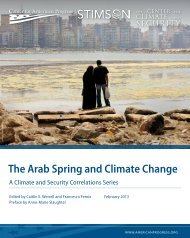Coal Kills
1TndvUf
1TndvUf
Create successful ePaper yourself
Turn your PDF publications into a flip-book with our unique Google optimized e-Paper software.
particulate control equipment (ESPs and cyclone bag filters) for removal of entrained ash. ESPs<br />
are installed in all coal-fired TPPs in India. As removal efficiencies at ESPs are higher for coarse<br />
particles, most of the PM dispersing from the top of the stack is in the size range of respirable<br />
PM. The PM in the flue gas also contains high concentrations of heavy metals such as arsenic,<br />
lead, cadmium, mercury, copper, and zinc, which not only contributes to potential health hazard<br />
than the bottom ash, but also increases the resistivity and reduces the ESPs collection efficiency<br />
to as low as 98%. A composite of the share of heavy metals in samples collected at the TPPs in<br />
Delhi and Kanpur is presented in Figure 5.<br />
Figure 5: Source profile of the heavy metals in a particulate sample collected from a<br />
power plant in Delhi and Kanpur (CPCB, 2010) 11<br />
Besides flue gas PM emissions, fugitive dust from coal-handling plants and ash ponds (after the<br />
disposal from the plants) is a problem. According to the Central Electrical Authority, after the<br />
combustion and application of control equipment, ash collection at the TPPs ranged 70-80% of<br />
the total ash in the coal. It is assumed that the remaining particulates is dispersed from the stacks.<br />
An amendment notification from MoEF mandates that 100% of ash utilisation within four years<br />
of generation; at least 25% of ash utilisation in all brick kilns within 100km radius of TPPs; and all<br />
building construction within 100km for any coal-fired TPP to use 100% ash based bricks, blocks,<br />
11 These samples from the coal-fired TPPs in Delhi and Kanpur were collected and analysed as part of the particulate pollution source<br />
apportionment study in six cities, commissioned by the Ministry of Environment and Forests, and executed by the Central Pollution<br />
Control Board (2010). Details of the program and results are available @ http://cpcb.nic.in/Source_Apportionment_Studies.php<br />
8 | <strong>Coal</strong>-fired TPPs in India




